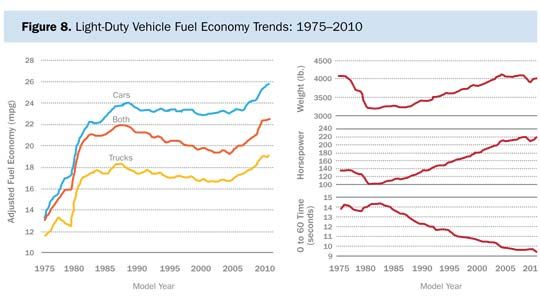Doubling the efficiency of current light-duty vehicles could save two million barrels of day within a decade, compared to the 1.6 million barrels per day that have come from the decades of developing offshore oil production in the Gulf of Mexico.
The data comes from the U.S. Department of Energy report, First Quadrennial Technology Review (PDF). The report, which will be updated every four years, splits energy into two separate buckets: transportation and electricity.
The report notes that there is about 6 percent turnover rate in light-duty vehicles every year, and if each old car were replaced by something twice as efficient, fuel consumption would drop by 3 percent per year. Over 10 years, that would be 30 percent, or 2.7 million barrels per day.
Although President Obama is currently being attacked for clean energy loans after the Solyndra mess and he has backed away from tougher air quality standards, the one area he has been bullish on is fuel economy standards.
There have been technological improvements in efficiency in the past decades, but these advancements have often gone to performance improvements, rather than how much fuel the car uses.

For the first time in a quarter century, CAFE standards were increased for light-duty vehicles, from 27.5 mpg in 2010 to 39 mpg in 2016. By 2025, cars will have to get 54.5 miles per gallon. Hybrids currently only make up about three percent of light-duty stock on the road, but sales of hybrids are growing.
A change in fuel economy labels on showroom floors will also show people differences in fuel costs over the lifetime of a vehicle between standard cars, hybrids, and electric vehicles. The administration also introduced the first MPG standards ever for medium- and heavy-duty vehicles earlier this year.
Along with government regulation, Consumer Reports noted that people are shopping for efficiency first. Sales of SUVs have lagged as the recession wears on, but gas prices continue to stay relatively high.
A Consumer Reports survey found that 73 percent of nearly 1,800 adult car owners are considering an alternative power train vehicle, according to Jim Guest, the President and CEO of Consumers Union, which produces Consumer Reports. Two-thirds of those respondents also said they planned on buying something with better fuel economy than their current car and 60 percent also said they’d be willing to pay more.
While fuel efficiency regulations and changing consumer ideals could help wean the U.S. off foreign oil and environmentally costly domestic oil, the other half of the efficiency puzzle -- electricity efficiency in buildings -- is a murkier prospect for the DOE to tackle. Check back in four years for signs of progress.



